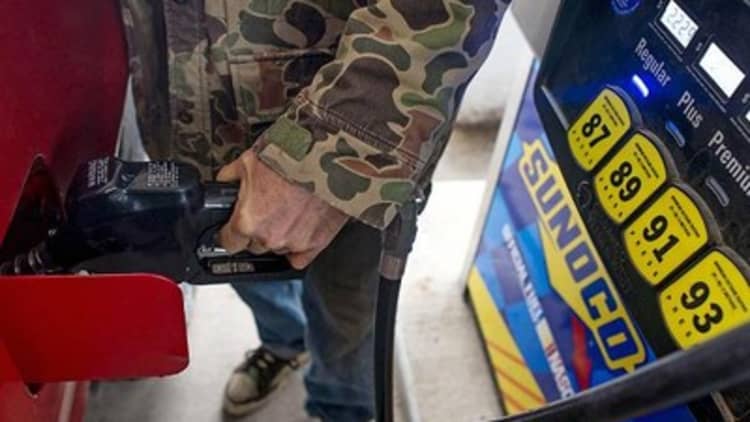
New data showing a surge in U.S. gasoline and diesel fuel supplies spell more trouble for oil prices but is good news for consumers.
The Energy Information Administration on Wednesday reported that U.S. gasoline stocks rose by 8.1 million barrels last week, compared with expectations for a 3.4 million barrel build. Distillate stocks, including diesel fuel and heating oil, rose by 11.2 million barrels, more than five times the amount expected.
Gasoline futures for February slumped more than 2 percent on the Nymex to $1.32 per gallon, but West Texas Intermediate oil futures rose slightly to $48.62 per barrel even though the large supply of refined products means lower demand for oil in coming weeks.
The data showed a bigger-than-expected drop of 3.1 million barrels in crude inventories last week, but it also showed that U.S. oil production rose again—to 9.132 million barrels a day, on par with the largest output in more than three decades.
Production was at 9.12 million barrels a day last week, and has been above 9 million barrels daily since early November.
The surge in U.S. production, largely from shale drilling, is what set off a price war between OPEC and other producers as U.S. crude displaced that of other competitors.
The Organization of the Petroleum Exporting Countries, at its last meeting on Thanksgiving, adopted a strategy of standing back and letting the market determine price. That has helped drive oil down further and faster than many analysts had expected. Analysts see oil prices weakening further through the second quarter before leveling off and rising in the fourth quarter.
"Despite the falling rig count, we tend to hover near 30-year highs in output," said John Kilduff of Again Capital. He said Wednesday's weekly data reaffirmed his negative outlook for oil prices.
U.S. oil production is expected to continue to grow over the next several months, as producers pump at current levels and some even more, particularly if they are cash strapped. Analyst say it will be several months before cutbacks in capital spending start to show up in decreased oil output.
"My outlook's pretty bearish. I don't know if it can possibly get more bearish," Kilduff said. "I still think we're going to punch the clock on $33 and see what happens from there."
Andrew Lipow, president of Lipow Oil Associates, said the growing supply of gasoline, coming just ahead of refinery switchovers for summer fuel production, could result in another dip in gasoline prices at the pump. He said the national average could now fall to $2 per gallon, from its current $2.19 level.
"It's just a stone's throw from $2," Kilduff said. "I think it gets there."
Summer fuel hits the market in April, so traders are monitoring April RBOB gasoline contract, which was trading 22 cents higher than the February contract Wednesday. Summer gasoline is typically more expensive.
Tom Kloza, oil analyst and founder of Oil Price Information Service, said he thinks the gasoline price will bottom between $2.13 per gallon and its current level. "I'm still in the camp that we're close to the bottom. It's always darkest before the dawn. There's no catalyst for gasoline demand in January," he said.
Brent futures briefly fell below $50 for the first time since May 2009, and WTI sold off overnight but rebounded.
"They were oversold overnight. WTI was down to $46. We saw exhaustive selling overnight, and we saw a lot of people try to buy several bottoms," Kilduff said.
Correction: An earlier version misattributed a quote. The speaker was John Kilduff not Tom Kloza.


